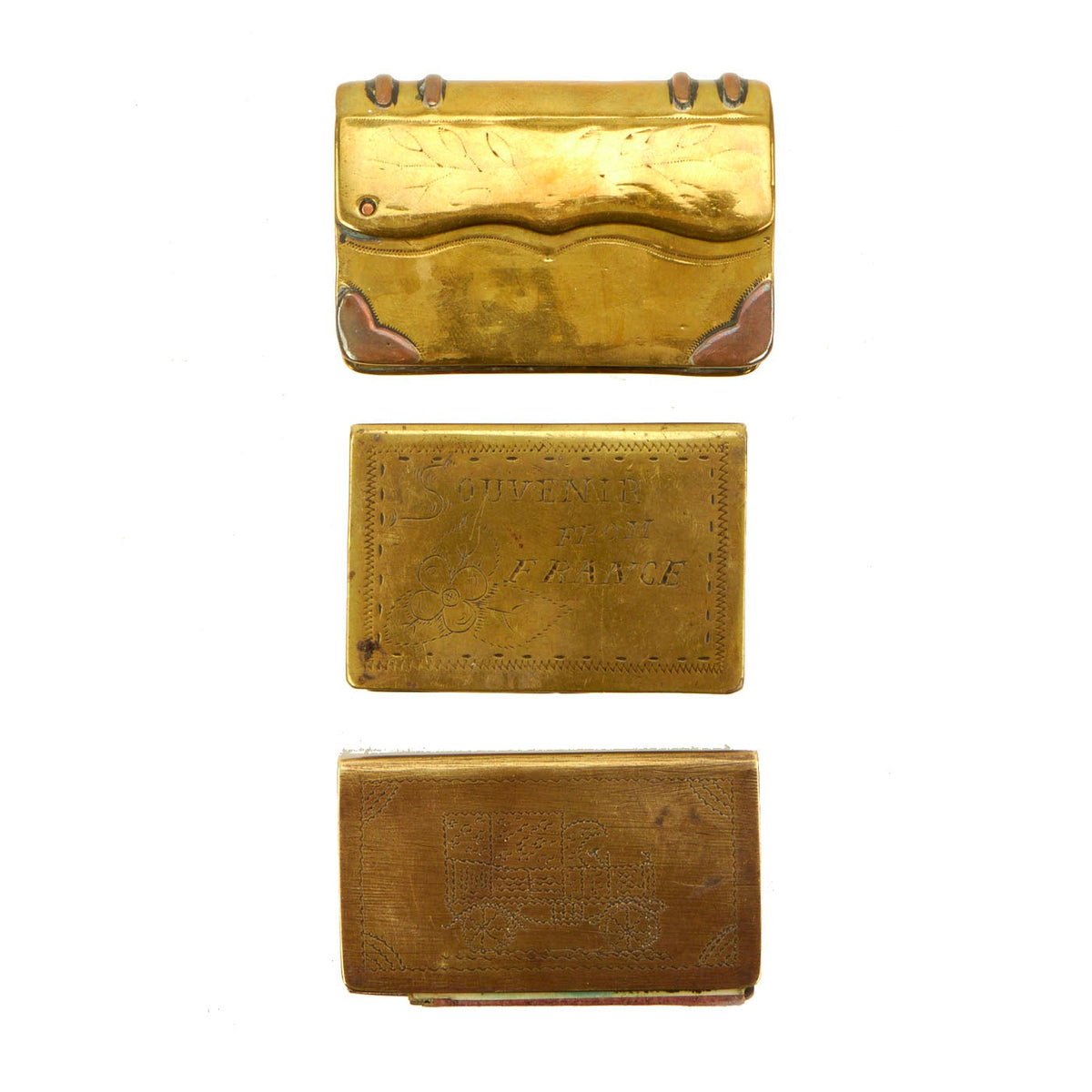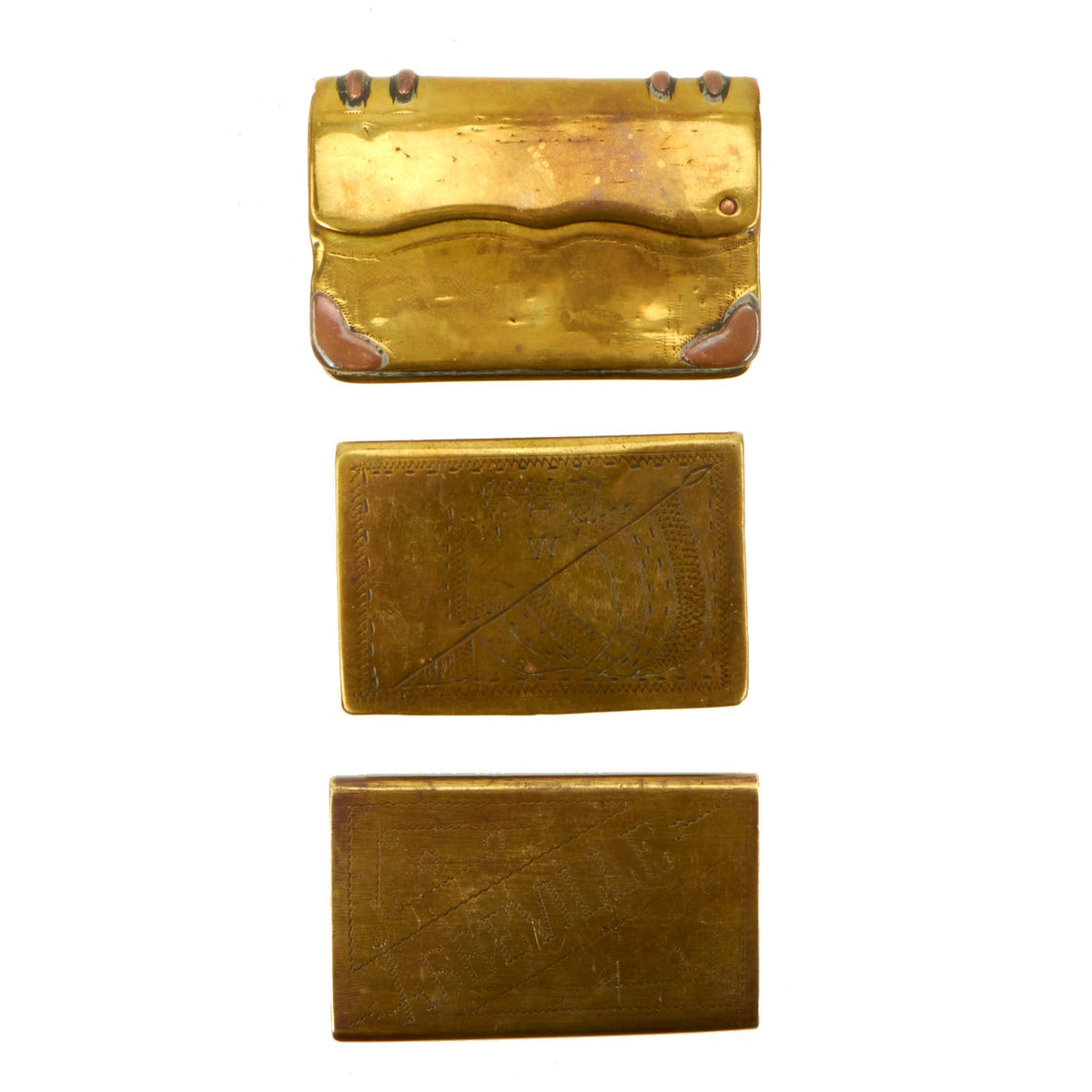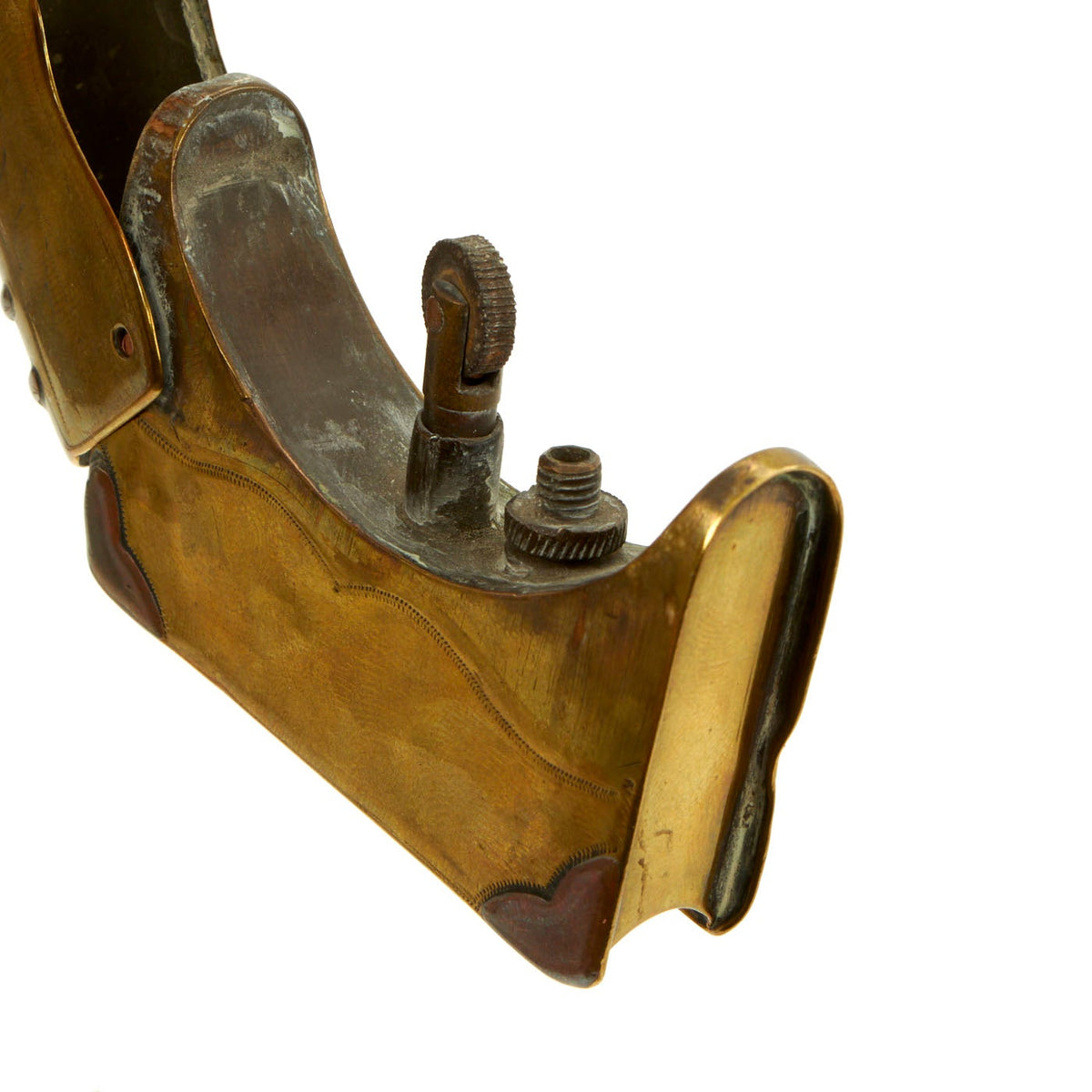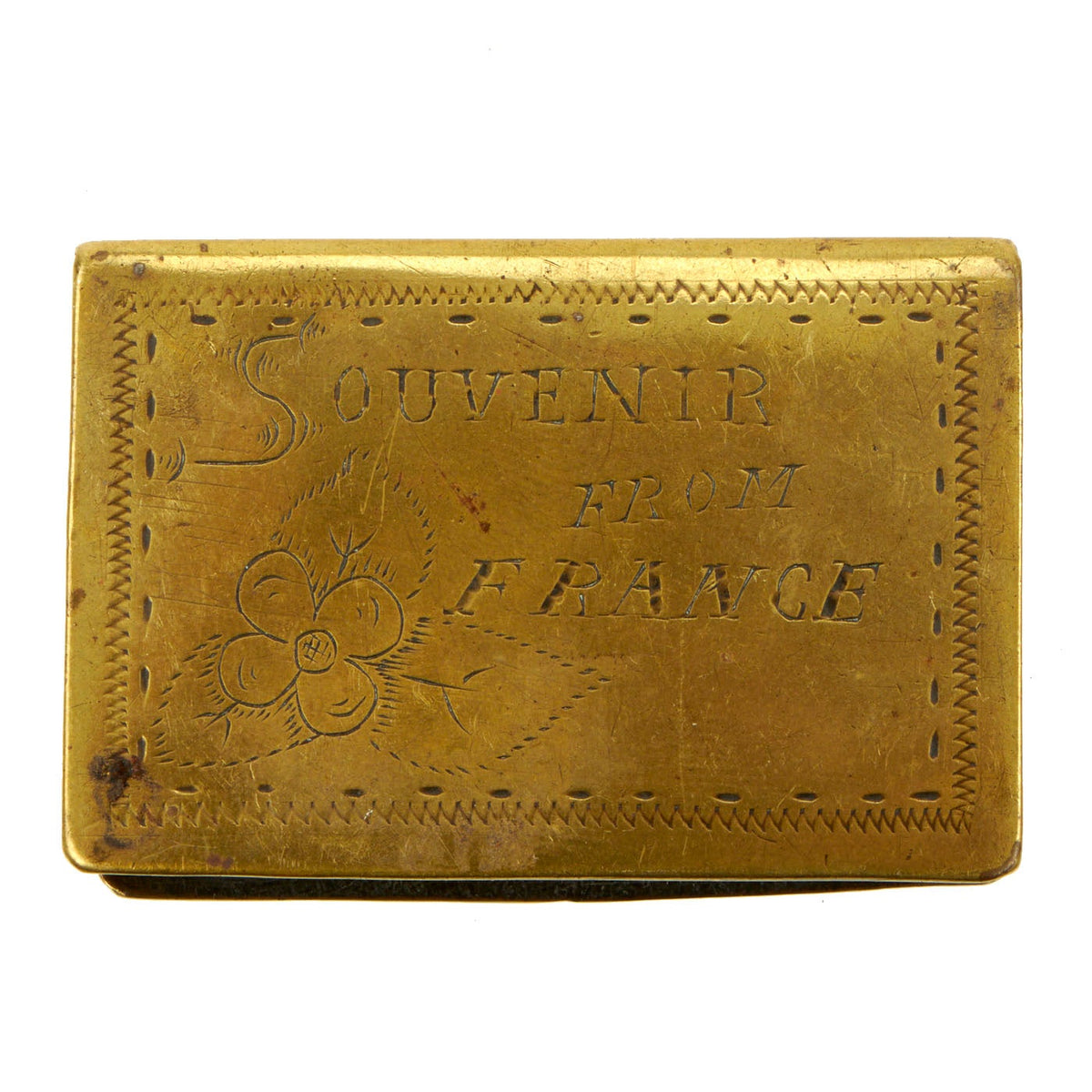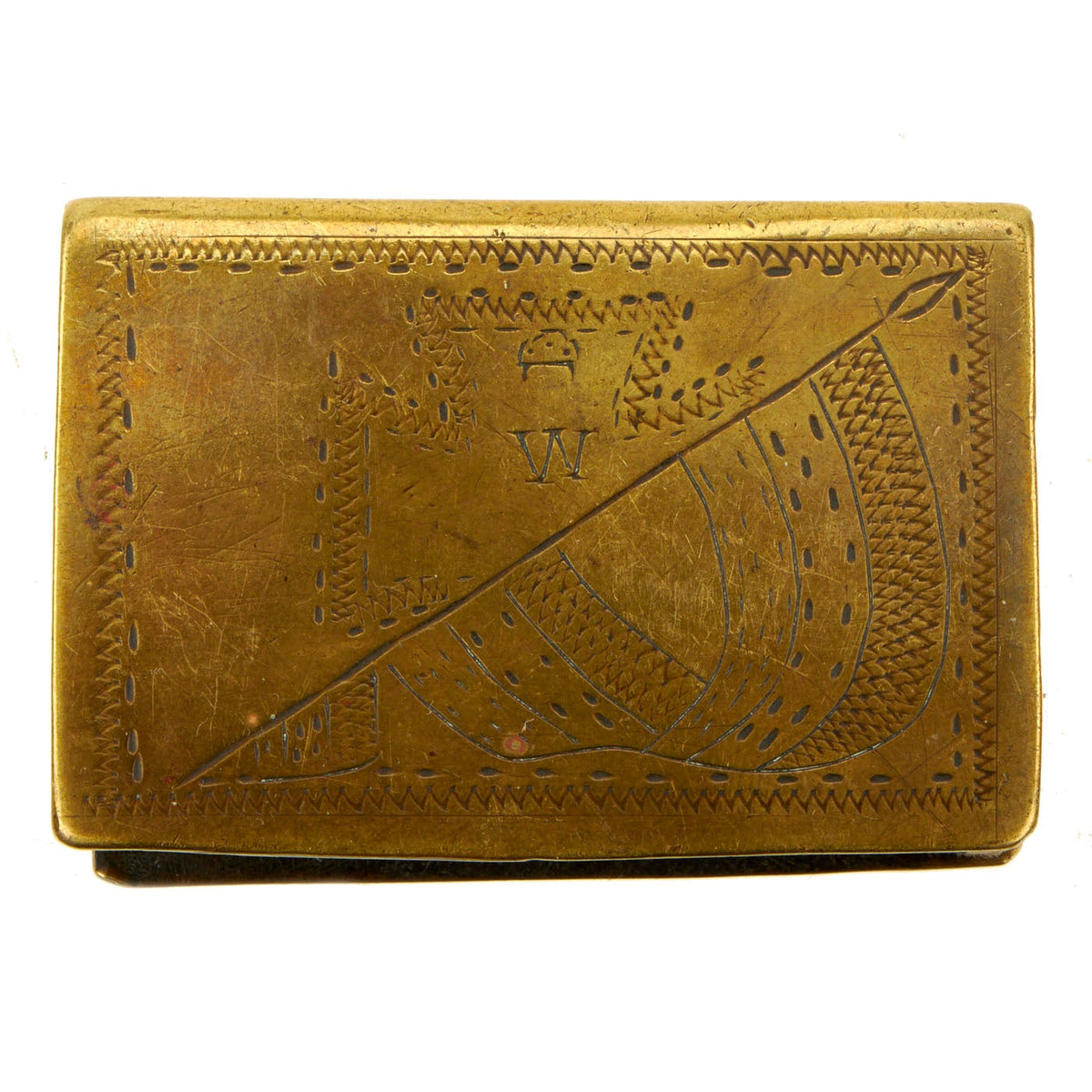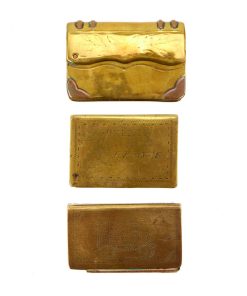Original French WWI Brass Trench Art Lighter and Matchbox Holder Set – 3 Items Original Items
$ 395,00 $ 118,50
Original Items: Only One Lot Available. Trench art is any decorative item made by soldiers, prisoners of war, or civilians where the manufacture is directly linked to armed conflict or its consequences. It offers an insight not only to their feelings and emotions about the war, but also their surroundings and the materials they had available to them.
Not limited to the World Wars, the history of trench art spans conflicts from the Napoleonic Wars to the present day. Although the practice flourished during World War I, the term ‘trench art’ is also used to describe souvenirs manufactured by service personnel during World War II. Some items manufactured by soldiers, prisoners of war or civilians during earlier conflicts have been retrospectively described as trench art.
The Items Included set are as follows:
-Trench Art Lighter: This is an absolutely beautiful example of a trench art lighter. Constructed of brass and what looks like copper, the soldier who made this lighter had designed it to look like a book. The spine of the book opens up revealing the flint strike wheel and eyelet for the wick and still is able to be unscrewed to reveal the much wider fill port. The lighter still has the original wick inside and it just need to be pulled up, filled, flint replaced and you’ll have a fully functional 104 year old lighter! The lighter is approximately 2 ½” tall and 2 ⅞” wide.
-Trench Art Matchbox Holder: This is another great example! The top of the box features a truck that was hand engraved and has a wavy rectangle border around the edges. The bottom of the lighter also has a wavy design and has “ABBEVILLE” engraved on it. The Battle of the Somme was fought within earshot of Abbeville during WW1 in 1916. This was a ferocious period of war. The Somme valley nowadays is a wonderfully peaceful seaside area to visit. The slaughter of the Great War during 1914-1918 is marked at various memorials all around Abbeville. The aerodrome on the northern edge of Abbeville was used by the French military during the Great War and is still in use. The box measures approximately 2 ½” x 1 ½”and still contains a wooden matchbox inside.
-Trench Art Matchbox Holder: This is another example of a brass matchbox holder. This one also contains an original wooden matchbox inside and the box says they were made in Norway. The face of the brass box has “Souvenir From France” with a flower in the bottom left corner engraved on it. The reverse side shows a WWI German Iron Cross and has a flag on a pole sitting diagonally, splitting the iron cross and covering the bottom of it. The box measures approximately 2 ½” x 1 ½”.
All 3 items are wonderful examples of Trench Art made during the Great War. They would display great in your WWI collections!
There are four broad categories of trench art:
-Items Made By Soldiers:
There is much evidence to prove that some trench art was made in the trenches, by soldiers, during war. In With a Machine Gun to Cambrai, George Coppard tells of pressing his uniform buttons into the clay floor of his trench, then pouring molten lead from shrapnel into the impressions to cast replicas of the regimental crest. Chalk carvings were also popular, with contemporary postcards showing carvings in the rocky outcrops of dug-outs. Many smaller items such as rings and knives were made by soldiers either in front line or support trenches, especially in quieter parts of the line. Wounded soldiers were encouraged to work at crafts as part of their recuperation, with embroidery and simple forms of woodwork being common.
Again from With a Machine Gun to Cambrai, George Coppard recalls that, while recuperating from wounds at a private house in Birkenhead, “one kind old lady brought a supply of coloured silks and canvas and instructed us in the art of embroidery. A sampler which I produced under her guidance so pleased her that she had it framed for me.” An example of therapeutic embroidery during World War I is the work of British military in Egypt, who were photographed sewing and embroidering for Syrian refugees. There was also the Bradford Khaki Handicrafts Club, which was funded in Bradford, UK, in 1918, to provide occupational therapy and employment for men returning from the trenches in France.
-Items Made By POWs and Internees:
The second category consists of items made by prisoners of war and interned civilians. POWs had good reasons to make decorative objects: free time and limited resources. Much POW work was therefore done with the express intention of trading the finished article for food, money or other privileges. Reference to POW work is made in the recollections of A B Baker, W.A.A.C., contained in the book Everyman at War, published by Purdom in 1930: “Part of my work had to do with prisoners quartered in a camp near to our own. Those Germans were friendly men. They were clever with their hands, and would give me little carvings which they had made.”
-Items Made By Civilians:
The third category is items made by civilians, which mainly means civilians in and around the conflict zone, but would also include items made by sweethearts at home.
In 1914, the US set up the Commission for Relief in Belgium, headed by Herbert Hoover. It shipped staple foodstuffs, mainly flour, in the printed cotton flour sacks typical of the period. As thanks, the Belgians would embroider and paint in the designs, elaborating them with dates and flags and send them back to the US. Examples of these are now in the Herbert Hoover Museum, but some were sold to soldiers in Paris or given as gifts.
Civilians in France, in the zones occupied by troops, were quick to exploit a new market. Embroidered postcards were produced in what quickly became a cottage industry, with civilians buying the surrounds and embroidering a panel of gauze. These postcards depicted regimental crests or patriotic flags and national symbols in abundance, and millions were produced over the course of the war. At war’s end, when civilians began to reclaim their shattered communities, a new market appeared in the form of pilgrims and tourists. Over the ensuing twenty years mountains of discarded debris, shell casings, and castoff equipment were slowly recycled, with mass-produced town crest motifs being stuck onto bullets, shell casings, fuse caps, and other paraphernalia to be sold to tourists.
-Commercial Items:
The fourth category is purely commercial production. After the war, tonnes of surplus materials were sold by the government and converted to souvenirs of the conflict.
Ship breaking, particularly if the ship had been involved in significant events such as the Battle of Jutland, resulted in much of the wood from the ship being turned into miniature barrels, letter racks, and boxes, with small brass plaques attached announcing, for example, “Made of teak from HMS “Shipsname”, which fought at the Battle of Jutland”.
Fast Shipping with Professional Packaging
Thanks to our longstanding association with UPS FedEx DHL, and other major international carriers, we are able to provide a range of shipping options. Our warehouse staff is expertly trained and will wrap your products according to our exact and precise specifications. Prior to shipping, your goods will be thoroughly examined and securely secured. We ship to thousands clients each day across multiple countries. This shows how we're dedicated to be the largest retailer on the internet. Warehouses and distribution centres can be located throughout Europe as well as the USA.
Note: Orders with more than one item will be assigned a processing date depending on the item.
Before shipping before shipping, we'll conduct a thorough inspection of the items you have ordered. Today, the majority of orders will be delivered within 48 hours. The delivery time will be between 3-7 days.
Returns
The stock is dynamic and we cannot completely manage it because multiple stakeholders are involved, including our factory and warehouse. So the actual stock may alter at any time. It's possible that you may not receive your order once the order has been made.
Our policy is valid for a period of 30 days. If you don't receive the product within 30 days, we are not able to issue a refund or an exchange.
You can only return an item if it is unused and in the same state as the day you received it. You must have the item in its original packaging.
Related products
Uncategorized
Uncategorized
Uncategorized
Uncategorized
Uncategorized
Uncategorized
Armored Burgonet Helmet & Polearm from Scottish Castle Leith Hall Circa 1700 Original Items
Uncategorized
Uncategorized
Uncategorized
Uncategorized
Uncategorized
Uncategorized
Angolan Rebel 1970s era 60mm Inert Display Mortar from Angolan Civil War Original Items
Uncategorized
Uncategorized
Uncategorized
Band of Brothers ORIGINAL GERMAN WWII Le. F.H. 18 10.5cm ARTILLERY PIECE Original Items
Uncategorized
Uncategorized
